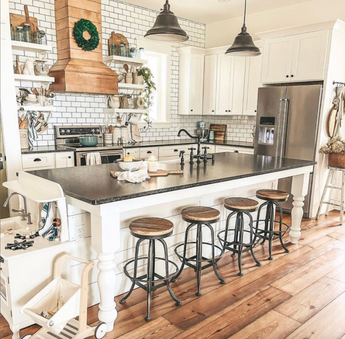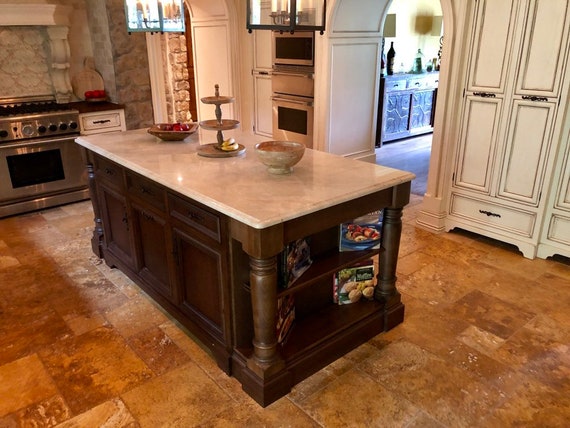How to Install a Kitchen Island Leg for Maximum Stability and Style
How to Install a Kitchen Island Leg for Maximum Stability and Style
Blog Article
Exploring the Important Features of a Kitchen Island Leg for Your Culinary Room
The kitchen island offers as a central hub in any culinary area, and the option of leg layout is pivotal in enhancing both its functionality and visual appeal. Understanding the vital attributes of cooking area island legs-- consisting of material alternatives, style styles, and stability variables-- can dramatically influence the overall experience within the kitchen.
Significance of Cooking Area Island Legs
Kitchen island legs play a vital function in both the functionality and visual appeals of a cooking area area. They not only sustain the weight of the island yet additionally enhance the total design, adding to the kitchen area's visual charm. The option of legs can dictate the style of the kitchen, be it modern-day, standard, or rustic.
Functionally, robust and appropriately designed legs make certain stability, allowing for the safe use the island for numerous jobs such as cooking, dining, or enjoyable. Strong legs prevent tottering and moving, giving a trusted surface for daily tasks.
Moreover, the elevation and positioning of the legs can affect the convenience level for those seated at the island. A well-considered elevation can fit bar stools or chairs, advertising an inviting environment for events.
Along with these useful factors to consider, kitchen island legs can serve as a focal factor in the room (kitchen island leg). Ornamental or distinctly created legs can boost the design visual, making the island a centerpiece. Hence, selecting the ideal cooking area island legs is necessary for balancing kind and function in any kind of culinary area
Material Options for Legs
Picking the appropriate product for cooking area island legs substantially influences both longevity and layout. Usual material choices include stone, steel, and wood, each offering distinctive benefits.
Wood is a preferred selection because of its heat and convenience. It can be quickly personalized to match different decor designs, from rustic to contemporary. Hardwoods like oak and maple give superb stamina and longevity, while softer timbers can be extra prone to tear and put on.
Steel legs are favored for their smooth, contemporary visual. kitchen island leg. Stainless-steel and light weight aluminum are not just durable but also immune to rust and rust, making them perfect for cooking area environments. They can create an industrial look and are frequently readily available in different coatings to complement other cooking area elements
Stone legs, such as granite or marble, include a component of high-end and security. While larger than other materials, they use extraordinary durability and can stand up to substantial weight. However, they may need added assistance to make certain proper balance.
Ultimately, the selection of material should straighten with both practical requirements and the total design vision of the cooking area area, guaranteeing that the island legs boost both utility and appearances.
Style Styles to Take Into Consideration
What style styles should be taken into consideration when selecting legs for a kitchen island? The option of leg design significantly affects the total visual of your culinary room. For a contemporary cooking area, smooth and minimalistic leg designs, such as stainless-steel or geometric shapes, can improve the contemporary allure, giving a tidy and minimalist look.
On the other hand, traditional kitchen areas take advantage of traditional designs such as transformed or carved wood legs, which include heat and personality. These alternatives frequently include elaborate details that complement classic home furnishings. For a rustic setting, take into consideration legs made from recovered timber or functioned iron, which bring an organic, earthy high quality to the room.
If you lean towards an industrial style, durable steel legs with a distressed surface may be ideal, providing an edgy yet advanced touch. Furthermore, farmhouse style cooking areas can incorporate beefy legs that evoke a sense of toughness and homeliness.

Height and Stability Variables
The height and stability of a kitchen area island are critical components that straight impact its capability and user experience. A perfect kitchen island leg should give adequate elevation to fit a range of tasks, from food preparation to laid-back eating.
Security is similarly essential, specifically as kitchen area islands typically serve as focal factors in culinary settings. The leg's accessory to the island's base must be secure, making certain longevity and resilience versus the wear and tear of everyday use.
Personalization and Devices
Modification choices and accessories blog here for kitchen area island legs can dramatically boost both the visual charm and performance of the room. Property owners can pick from a selection of products, including stone, metal, and timber, enabling smooth integration with existing kitchen area decor. The option of coating-- be helpful hints it a natural discolor, repaint, or powder finishing-- more personalizes the look, making certain that the island complements the general layout theme.
In enhancement to product and finish, house owners might also explore the consolidation of devices such as attractive braces, adjustable feet, or integrated shelving. Brackets can use added support while contributing to a contemporary or rustic visual. Flexible feet are specifically advantageous for unequal floor covering, making certain the island continues to be stable and level, which is important for both safety and security and use.

Final Thought
To conclude, kitchen island legs serve a critical role in supplying security and enhancing the overall aesthetic of the culinary area. The option of products and design styles adds to both performance and aesthetic allure, while factors to consider of elevation and stability guarantee functional usage. Furthermore, customization choices and accessories can raise the kitchen area island, making it a distinct prime focus within the home. Thus, careful consideration of these features is crucial for a reliable cooking area layout.
The kitchen area island serves visit site as a central center in any kind of cooking area, and the choice of leg design is pivotal in boosting both its capability and aesthetic charm. Understanding the essential functions of kitchen island legs-- consisting of material alternatives, style styles, and stability factors-- can dramatically affect the overall experience within the cooking area.Kitchen area island legs play an important role in both the capability and visual appeals of a kitchen room.What style styles should be considered when selecting legs for a kitchen island?In verdict, kitchen area island legs offer an important role in giving stability and boosting the general visual of the culinary room.
Report this page